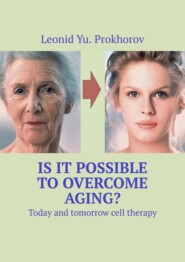скачать книгу бесплатно
– have a limited lifespan;
– possess the property of contact inhibition of divisions and require attachment to the substrate (bottom of the culture flask) for proliferation;
– have no oncogenic potency, i.e. there is a safety of autologous fibroblasts (Keller et al., 2000), there are no tumors in athymik (non-immune) mice after 2 months after the administration of 40 million cells;
– have normal contractility as referred to collagen;
– maintain in vitro an active synthesis of type I collagen after in vitro cultivation for 6 passages.
Specialists in one of USA firms claims that they have already executed thousands of similar procedures, and thousands of patients are treated. With the help of similar techniques in cosmetology, it is possible to correct age-related changes in the skin, wrinkles, skin scars. The use of person’s own cells is justified by the fact that there is no rejection reaction, often arising from the use of another person’s cells, both of embryonic origin and even more so, when received from adult donors. In addition, there are no ethical problems arising from the use of embryonic cells.
Examples of application of techniques are also shown in other figures. Thus, in figures 14a, 14b, 14c shows the face of
a patient with nasolabial fold (wrinkle) before the procedure with autologous fibroblasts (a), during cell therapy (b) and several months after it (c). It can be clearly seen that wrinkles are significantly reduced (smoothed) and almost disappeared. This was due to the fact that the administered autologous fibroblasts successfully adapted and began to produce new, young collagen and elastin.
In the fig. 15a one can see part of the patient’s face before the procedure of autologous fibroblasts and in fig. 15b – 4—6 months after the therapy. The arrow shows a defect on the skin before and after therapy. A defect is a scar on the surface of the cheek after removal of warts (Watson et al., 1999).
The corrections of other such senile changes in the skin are also possible (Weiss et al., 2007).
CRYOSTORAGES
After the use of cell therapy, some cells may be still not utilized. These cells should be preserved in order to repeat the procedure in the distant future.
To preserve your own cells, you need to place them in a special cryostorages. It is a duralumin or steel container, made like a type of thermos, with double walls, between which a vacuum is created. It is filled with liquid nitrogen having a temperature of minus 196
C (Figures 16a, 16b).
Before freezing, the cells are washed from the growth medium and kept in a protective solution that prevents them from damage at low temperature.
Cell suspension is poured into special sterile plastic vials, closed hermetically. These ampoules with cells inside are first subjected to gradual smooth cooling to minus 70—80
С, after which they are immersed in liquid nitrogen in the cryostorage, where they remain for many years and decades. Each of the cryovials is assigned a unique identification number, which is entered into a computer database. This number is strictly consistent with the person from whom the cells were taken. The database contains the following data: name and surname of the person, date of birth, blood characteristics, information about hereditary diseases, the date of taking a biopsy, some other information.
The database exists not only in the computer, but the information is also duplicated on CDs or USB flash drives which are stored in a dedicated place. This eliminates the loss of information. The cryopreservation itself is constantly under the supervision of the personnel on duty, it is excluded from the access of unauthorized persons, and all manipulations with containers are made only by carefully trained personnel who are personally responsible for the safety of cellular material.
In such a cryostorage the fibroblasts or other cells can be stored indefinitely, and if necessary, part of them can be extracted, thawed and used for cell therapy of the skin, organs or other purposes in the future.
FUTURE PROSPECTS
Skin is a very important human tissue that carries significant body functions: it protects against penetration of the microorganisms, prevents the drying of muscle tissue, regulates temperature balance by sweating. However, in humans, there are other, not less important tissues and organs. All of them are also subject to aging.
We are confident that the method of cell therapy will be used in the near future to restore other aged or sick tissues or organs, such as muscles, liver, kidneys, heart, etc. (Prokhorov, 2004).
It should be noted that almost all of the more than 2-fold increase in average life span (ALS) over the last century, from the late 19th-early 20th century to the present day occurred due to the successes of medicine. All increase in ALS occurred due to improved treatment of infectious diseases, diseases of the cardiovascular system, cancer. This made it possible to increase the ALS of men in developed countries from 30—40 years in the late 19th century to 60—80 years (men and women) at the end of the 20th century. It is difficult to talk about how the maximum life span (MLS) has increased, since there is often no confidence in the date of birth of a long-living persons born before the 20th century. Still, with some caution, we can say that the MLS, in contrast to ALS, over the last century has increased insignificantly and now stands at about 115—120 years. Reliably registered is 122 year record (Guinness Book…, 2020). It is believed that in the upper paleolithic period (30 000—12 000 years ago) the MLS was already 95 years old (Dilman, 1986).
Вы ознакомились с фрагментом книги.
Для бесплатного чтения открыта только часть текста.
Приобретайте полный текст книги у нашего партнера:
